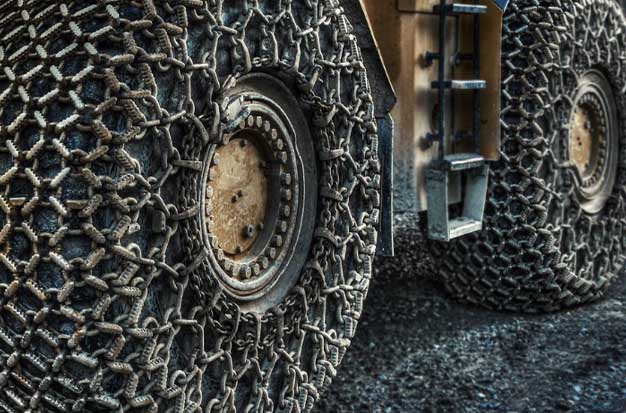
How Fast Can You Drive With Chains – When To Use
How quickly can a car travel with chains on? This query comes up frequently. And the response is based on a few variables. Your driving technique, the size of your tires, and the type of snow chains you’re using are the three main factors.
You simply exceed the tire’s ability to convert heat into work if you press the brake pedal for a prolonged period of time, which causes the tire to heat up too quickly. The tire softens as a result, and its rolling resistance significantly increases.
What Are Snow Chains
In order to provide tires with the extra traction they require on snow and ice, people use snow chains, tire chains, tire cables, or cable chains. Either flexible steel lattice with additional hooks or steel cables with hooks on the ends are used to construct them.
Snow chains are designed to allow drivers to navigate terrain that is too hazardous for regular tires, which is typically icy or snowy roads.
Any vehicle with pneumatic tires, including sleds, vintage horse-drawn carriages, SUVs, and large trucks, can be fitted with chains. Skid shoes and cleats are the traction devices used on hauling trailers.
How Fast Can You Drive With Chains
When using snow chains, you should limit your vehicle’s speed to between 20 and 30 miles per hour (between 30 and 50 kilometers per hour). Even if you wanted to, your car won’t be able to travel with chains on the tire at its top speed on a snowy road.
With snow chains, you shouldn’t attempt to drive more quickly than 20 to 30 mph. The chains may make your car slide out of control when braking or steering if you drive over a dry patch of the road.
Driving conditions that include tire chains and snow on the road are not typical. Your car’s fuel economy and speed are both negatively impacted by this situation.
Your state’s authorities mandate that you put snow chains on your tires when you travel on roads and streets with a lot of snow for your safety. You are only capable of traveling at a maximum speed of 20 to 30 mph in such circumstances. With chains, going any faster than 20 to 30 mph can make your car slide out of control when braking or steering.
Tips For Driving Truck On Winter Snow
Snow chains can help you escape challenging circumstances in snowy weather, but not if you drive too quickly. Tire chains are primarily used to provide you with a safe means of traveling an unsafe road. Driving with extra caution is advised in hazardous road conditions.
Here are some safety recommendations for using snow chains while driving:
Keep to a Safe Speed
Only a certain amount of abuse is what tire chains are made to withstand. When chained, motorists shouldn’t go faster than 30 mph. Any faster could lead to chains breaking while in motion. Both drivers and vehicles may be in danger from this.
Routine Inspections Are Necessary
When using chains for the first time, drivers will inevitably tighten them. However, it is generally advised that chains be checked and tightened again on a regular basis. As the miles pass, chains will become more brittle as a result of becoming looser.

Chained Tighteners Can Cause Problems
When not used properly, chain tightening tools have a propensity to pull chains out of alignment. A driver who is unfamiliar with using such a device should refrain from doing so. Chains can be effectively tightened in other ways.
Avoid Bare Pavement
Additionally, tire chains do not hold up well against bare pavement. Driving short distances on bare pavement may therefore occasionally be necessary, but it should generally be avoided. When passing through a region with snow-covered roads, a driver needs to find a place to pull over and take the chains off.
Chains Slip-on Pavement
Chains also have the tendency to slip on uncoated pavement, which is worth noting. Drivers must brake more gently if they are still chained up and traveling on bare pavement. It is very simple to slide on chains and lock the wheels. On the other hand, pressing the gas pedal too hard might cause the drive wheels to spin on bare pavement. Drivers should only amplify gradually.
When Should You Put On Snow Chains?
Consequently, when should snow chains be worn? whenever you’re moving at a rate well below the point at which your car will stall. Your tires simply won’t be able to generate enough traction to keep the car moving forward at 30 mph.
The tires must be capable of exerting at least 1.5g of braking force in order to maintain a constant speed of 30 mph or more; however, most passenger cars cannot do this without severely overheating both their brakes and tires if the roads are slick.
Depending on the road conditions, the tire quality, and various other factors, you should anticipate lower acceleration and top speeds with snow chains than without them if you put them on at highway speeds (more than 35 mph).
If you apply chains while traveling at a high speed, you’ll need to reduce your throttle and work to prevent the car from slipping too far. Snow chains can be used to safely travel at highway speeds in the right circumstances.
However, it’s preferable to keep the car moving at 25 mph or less if there’s a strong crosswind or less-than-ideal snowy conditions.
Put on the next size smaller chains and keep going slowly until you reach safety or a location where you can step out and inspect the issue. If your tires become soft due to an abrupt loss of stopping power, which happens more frequently than you might think, don’t panic.
Factors Affecting How Fast You Can Drive With Snow Chains
The following are some factors that will reduce your speed on snowy roads and streets even if your tires have chains:
Actual Condition of the Road
You can travel at a reasonably fast but not excessively fast speed if the snow on the road has already been compacted. However, you must proceed more slowly if there is a recent accumulation of snow on the road.
Age of the Tire Chain
Your confidence in using the tire chain will increase as it gets newer, and your car’s speed will increase as well. If you use a tire chain from an old tire, the opposite will be true.
Experience
You will probably move slowly if you have never used a snow chain before. Once you’ve used it several times, you’ll feel more at ease and be able to drive more quickly.
Fit of the Chain
You’ll have more traction on the road and more speed if the snow chain and tire fit snugly together. But you need to go slower if it fits loosely. Use the appropriate chains for the size of the tires.
Conclusion
It’s critical that the snow chains on your tires are installed correctly. If not, your tires might sustain minor aesthetic damage, especially if you accelerate the vehicle. When driving in snowy conditions, be careful and reduce your speed to below 30 mph.
When you leave in the morning, the weather might not seem too bad, but as you drive, icy patches may appear on the roads without warning. When you arrive, it may be too late to turn around because you won’t know how the roads are until you get there.



Average Rating